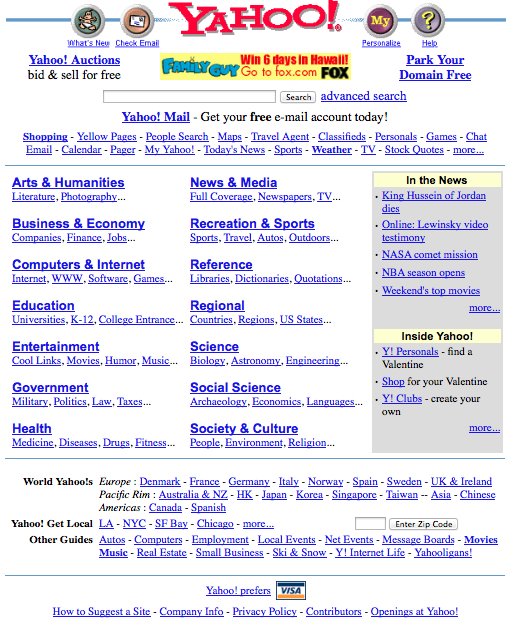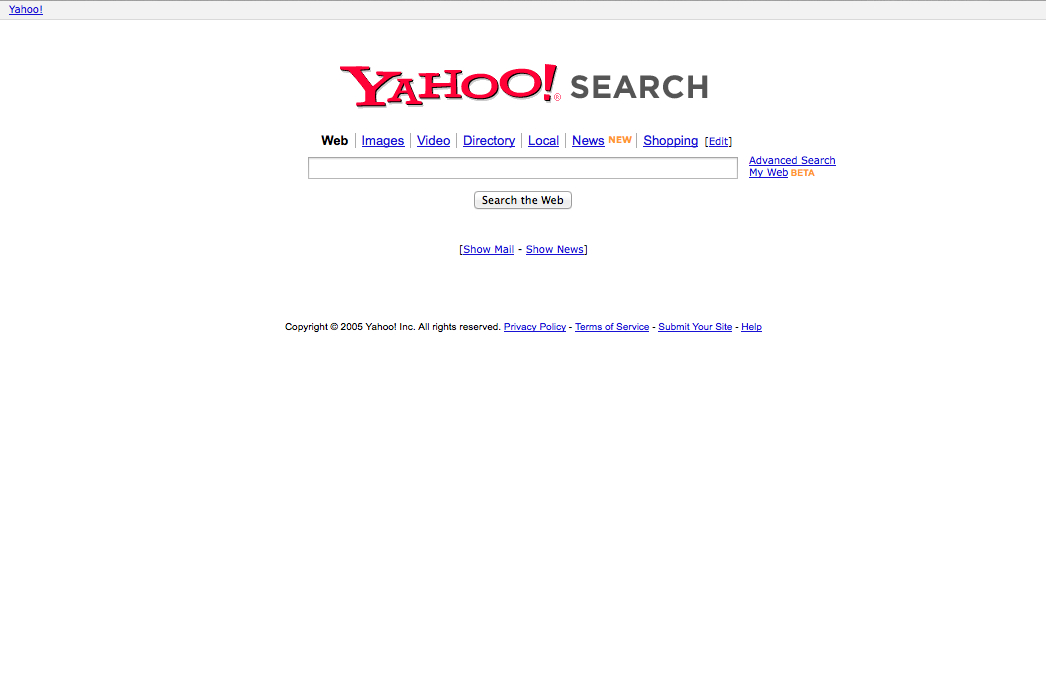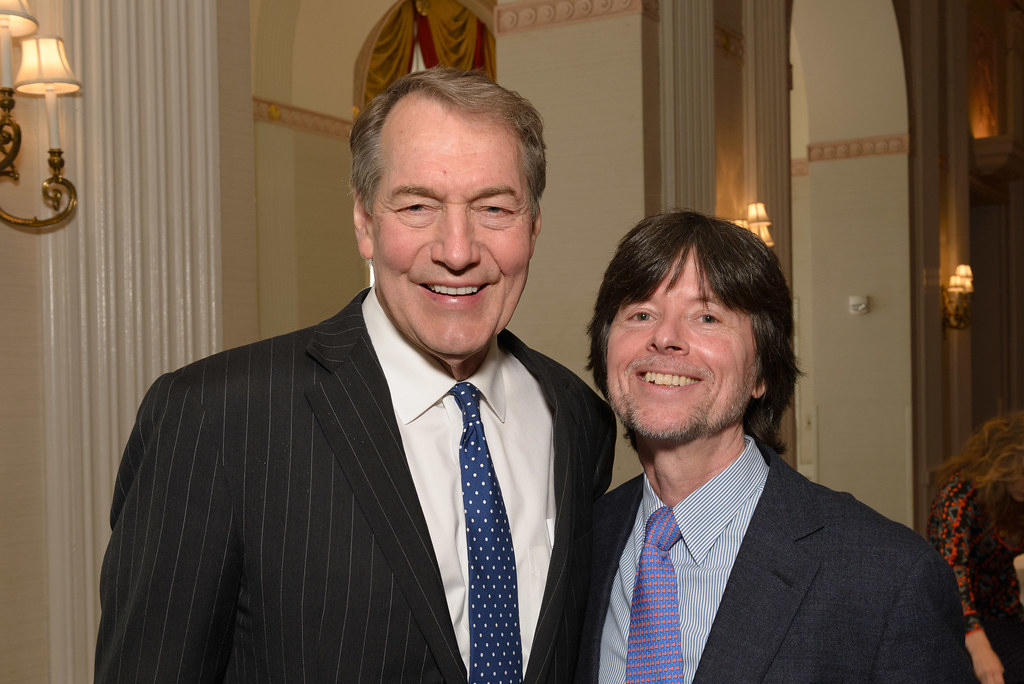When reflecting on Google services, it made me realise how much the internet has changed. Back in 2005 when I started work at Yahoo!, the internet was a very different place. It was an exciting time, web 2.0 was a technological and philosophical step-change for online services. We had cleared our palates of the bad taste left by the silliness of the dot com implosion.
Social networks weren’t mainstream in the way we would understand them now – though there were social networks prior to the the then nascent Facebook. Instant messaging was just starting to move on to mobile devices and were more a source of ‘presence’ information – whether someone was free or not than mobile messaging. Instant messaging on the desktop was big and everyone thought that Skype actually worked really well at the time.
We were conscious of security, but again Skype promised privacy and security (except in China) through secure encryption. The 800LB gorilla in the room was Google. Yahoo! had managed to survive the dot com bust and subsequent 30+% drop in online advertising revenues because of the Yahoo! Dating business. Even in a recession people still need love. By comparison, Google had been on a tear, Adwords promised marketers greater transparency where they money had gone and what action had been derived from their advertising spend. There were even some nice charts that they could cut-and-paste directly into a PowerPoint presentation.
Google services impact was much bigger. Yahoo! had pioneered search with Jerry Yang and David Filo’s directory in the mid 1990s. You can still find an iteration of the directory at Yahoo! here. In 1999, the front page of Yahoo! still reflected that directory heritage, as you can see from this screen shot

By the time I joined Yahoo! we had a search page that looked much more like the clean design of Google’s search page. The product was comparable in performance to Google as well, it just wasn’t Google; which is what most UK web users wanted.

We struggled to get media mentions for Yahoo! in comparison Google services coverage wrote itself: Google spots Jesus in Peruvian sand dune | The Register. Products like Lycos’ IQ service didn’t get the attention they deserved because if it didn’t come from Google the digerati weren’t interested. At the time Google had 70% or so of the share market, rumours I heard at the time from colleagues were that up to 95% of searches from Yahoo!’s UK office actually used Google – which foreshadowed Google’s European dominance.
Google’s dominance could be said to have peaked around 2006, social was starting to appear and consumers started to learn the downside of what beta meant as services started to disappear or become amalgamated into other products. Services that they wove into the fabric of their online life disappeared. Tools that helped them work became less useful as functionality was dialled back.
I have compiled a list of Google services that have been launched and closed. I ignored US-only products. There are some specific omissions:
- Deja News had been already shutdown by the time Google acquired the company, Google sucked the service’s Usenet archives into Google Groups
- Google launched ‘Click-To-Call’ twice. It was closed down for the first time in 2007 and was trialled again in April 2010
- Hello was a Picasa-based picture file transfer app similar to ‘send file’ on your favourite instant messaging platform, it was axed in 2008, but it always felt like a feature to me rather than a product
- SearchMash always was a testbed for different search user experiences. It was not a product by any stretch of the imagination
- Google PowerMeter was a piece of software from Google.org – the charitable foundation set up by Google
- Google Directory used data pulled from the Open Directory Project, it just ranked them using its algorithm
- Google Pack was a marketing ploy and possible revenue generator rather than a consumer product per se
A number of businesses that Google got involved with where acqu-hires:
- Aardvark
- BumpTop
- DocVerse
- Dodgeball
- fflick
- Gizmo5
- Jaiku,
- Meebo
- Picnik
- Postini
- Quickoffice
- Slide
- Zingku
Spun-out / rebranded products
| Product name |
Date of launch (DD/MM/YYYY) |
Fate |
| Google body |
15/10/2010 |
Google Body was part of Google Labs. It was handed over to Zygote Media Group on October 13, 2011. It is now called Zygote Body. The source code is available under an open source license |
| Google gears |
31/05/2007 |
Removed from Google’s product set, Gears was released under a BSD license. News of Google’s migration away from Gears broke in November 2009 |
Discontinued products
| Product name |
Date of launch (DD/MM/YYYY) |
Fate |
| Google answers |
04/2002 |
Google has taken a number of runs at Q&A services. Google Answers shut down was announced on November 28, 2006 |
| Google deskbar |
06/11/2003 |
Google Deskbar came out of Google Labs; it put a Google search box inside the chrome of the operating system, allowing consumers to Google not just from inside the browser, but also productivity software. It was discontinued on May 8, 2006. A similar feature was incorporated into Google Desktop Search. |
| Orkut |
24/01/2004 |
Facebook-like social network that used to be popular in India and Brazil. |
| Google desktop |
14/10/2004 |
Searched across the computer similar to Spotlight in OS X and a web search box a la Google Deskbar. Desktop also had Konfabulator-like web applets that provided information on weather, news etc. It was announced that it would be discontinued on September 2, 2011 |
| Google Notifier |
2005 |
I can’t find a specific date in 2005 when Notifier was launched. It let desktop users now when an event was due on their Google calendar or an email available in Gmail |
| iGoogle |
05/2005 |
Discontinued on November 1, 2013 |
| Google talk |
24/08/2005 |
Google’s VoIP client, replaced by Google Hangouts on May 2013 |
| Google reader |
07/10/2005 |
Google closed down Reader despite the outcry from users. According to Google it had a loyal but declining user base so shut it down on July 1, 2013 |
| Google page creator |
24/02/2006 |
A simple way of web publishing, which Google replaced with Google Sites in September 2008. |
| Google notebook |
10/05/2006 |
Google Notebook was a bit like a proto-Evernote. Content was exported to Google Docs on November 11, 2011 and the service disappeared by July 2012. On March 20, 2013, Google launched a similar service called Google Keep |
| Google brower sync |
08/06/2006 |
Rolled out of Google labs as a way of synchronizing settings, passwords and bookmarks across say work and home computers running the Firefox browser. Google’s Chrome browser has a similar function and shutting this function down would have been designed to persuade consumers to jump ship when it was discontinued in June 2008. |
| Google image labeler |
31/08/2006 |
Google copied the idea behind Carnegie Mellon’s ESP game to find a better way to teach its search what images were. Since it depended only on common answers from two random players, it prevented foul play so to speak. It was shut down on September 16, 2001 |
| Google code search |
05/10/2006 |
Vertical search looking at open source code on the web, announced for shutdown on January 15, 2012 |
| Google website optimiser |
10/2006 |
Free website testing tool to enable site owners to get more value from their site. Discontinued on August 1, 2012 |
| Google question & answers |
28/05/2007 |
Google’s latest attempt at a Q&A service was ran as localized services in Russia, France, international English and China through a partnership with Tianya. It was closed down on June 23, 2014 |
| Knol |
13/12/2007 |
Kind of similar to Squidoo in that it allowed experts to develop a sphere of content as user-written articles. It was announced on November 22, 2011 that it would be shut down. |
| Google friend connect |
12/05/2008 |
A social media profile that was exportable (possibly as a widget), what Wikipedia called a social networking script. Google signaled it was killing it off on November 23, 2011 to make way for Google+ |
| Google health |
20/05/2008 |
Centralised personal health record service. It didn’t get to the UK but did influence David Cameron’s thinking on health IT. Discontinued January 1, 2012 |
| Google lively |
08/07/2008 |
Google Lively was a way of creating a SecondLife-type environment for conference calls – one of the reasons why IBM was so interested in SecondLife in the first place. Lively was discontinued on December 31, 2008 |
| Google insights for search |
05/08/2008 |
Google Insights for Search was merged with Google Trends on September 27, 2012 |
| Google latitude |
05/02/2009 |
Location aware social application, similar to Dodgeball that Google had acquired and closed down. Latitude itself was shut down on June 10, 2013 |
| Google squared |
12/05/2009 |
Google squared provided some of the functionality of Wolfram Alpha, in particular adding structure and relationships to apparently unstructured data sets. It was shut down on 05/09/2011 |
| Google wave |
27/05/2009 |
Google Wave was a hybrid communications platform that allowed document collaboration and a mix of email and messaging. Google Wave was culled in a batch of ‘spring cleaning’ announced by Google in November 2011. Source code from Google Wave was released under an Apache license. |
| Google fast flip |
14/09/2009 |
Provided a flip board type of experience aggregating content from 39 news partners. It was axed on September 5, 2011 |
| Google building maker |
13/10/2009 |
Allowed users to model existing buildings for inclusion in Google Earth as a 3D model. Shut down announced on March 13, 2013 |
| Google dictionary |
12/2009 |
Google Dictionary was launched as a standalone product after being a feature in Google Translate. It was shut down without warning on August 5, 2011. Google has a dictionary function build into search using ‘define:” |
| Google buzz |
9/2/2010 |
A social network that integrated into Gmail, it was discontinued on December 15, 2011. |
| Google cloud connect |
24/2/2011 |
Google Cloud Connect was a Microsoft Office plug-in that allowed you to easily save documents to Google Docs. It was discontinued on April 30, 2013 |
| Google schemer |
18/11/2011 |
An invite-only clone of 43 Things was shut down on February 7, 2014 |
| Quickoffice |
05/06/2012 (date Google acquired the company) |
Quickoffice was an established mobile application when Google acquired the company, discontinued on June 29, 2014 |
The closure of Google Reader felt to me like a water shed moment. Google Reader had come along and eviserated the current marketplace for RSS readers, though the size and reach of the Google network. Names like Fastladder and Bloglines disappeared. Once the competition was demolished Google then withdrew of the sector and a scramble of cottage industry services sprung up to try and fill the gap; my personal favourite being Newsblur.
I suspect and have heard others suggest that Google has a problem getting users to use and commit to new services. I don’t think that Google Wave’s issue was consumer commitment, but poor product design, but the lack of adoption for say Google+ screams consumers and early adopters could be indicative of a wider wariness of the general public to invest their data and time in a new Google service. This maybe part of the reason why Google seems to be gradually extracting Google+ from its product matrix; just a few days ago no longer using Google+ author ranking in search.
If one looks at Google+ versus other services in Google Trends we can see a similar level of interest to say Google Reader, something that Google has already admitted was a non-viable product.
Google finds itself in a more normal internet brand marketing position: asking consumers for brand permission to innovate so that consumers will engage with their new products and services. Having been on the other side of that fence I realise what a challenge that can be. More Google related content here.
More information
Lycos IQ
Lovely Jubii-ly | renaissance chambara
IAC | Ask and the social web | renaissance chambara
Open source intelligence | renaissance chambara
Google Click To Call
Google Tests Phone Numbers In AdWords Ads | SearchEngineLand
Google Reader
Reader May Have Died To Feed Google+’s APIs | Co.Labs
Google Answers
Adieu to Google Answers | Google Official Blog
Google Deskbar
Google’s Deskbar; Search Engine Forums Spotlight | Search Engine Watch
Google Lively
Be who you want on the web pages you visit | Google Official Blog
Google Questions and Answers
Baraza turning read only | Google Help
Google Groups
How to Search Today’s Usenet For Programming Information? | Slashdot
Google’s Abandoned Library of 700 Million Titles (UPDATED) | Wired
Google Begins Fixing Usenet Archive | Wired
Google Wave
More spring cleaning out of season | Google Official Blog
Google Gears
Stopping the Gears | Google Gears Blog
Google+
It’s Over: The Rise & Fall Of Google Authorship For Search Results | SearchEngineLand



